Lin Yuan
Towards Generalized Proactive Defense against Face Swappingwith Contour-Hybrid Watermark
May 25, 2025Abstract:Face swapping, recognized as a privacy and security concern, has prompted considerable defensive research. With the advancements in AI-generated content, the discrepancies between the real and swapped faces have become nuanced. Considering the difficulty of forged traces detection, we shift the focus to the face swapping purpose and proactively embed elaborate watermarks against unknown face swapping techniques. Given that the constant purpose is to swap the original face identity while preserving the background, we concentrate on the regions surrounding the face to ensure robust watermark generation, while embedding the contour texture and face identity information to achieve progressive image determination. The watermark is located in the facial contour and contains hybrid messages, dubbed the contour-hybrid watermark (CMark). Our approach generalizes face swapping detection without requiring any swapping techniques during training and the storage of large-scale messages in advance. Experiments conducted across 8 face swapping techniques demonstrate the superiority of our approach compared with state-of-the-art passive and proactive detectors while achieving a favorable balance between the image quality and watermark robustness.
MLEP: Multi-granularity Local Entropy Patterns for Universal AI-generated Image Detection
Apr 18, 2025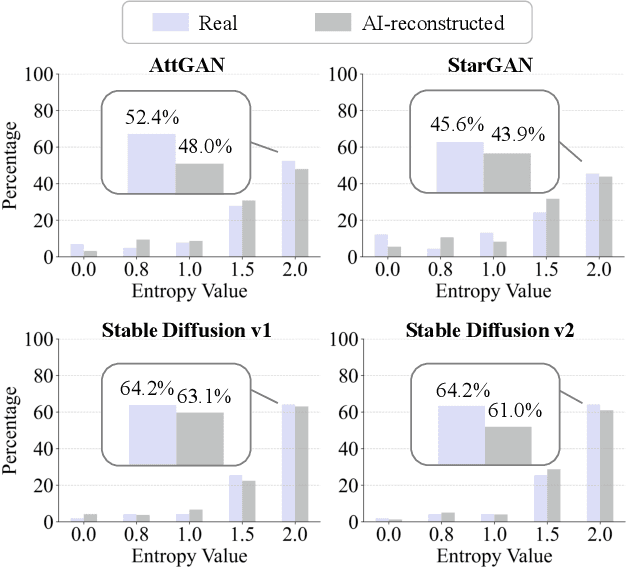
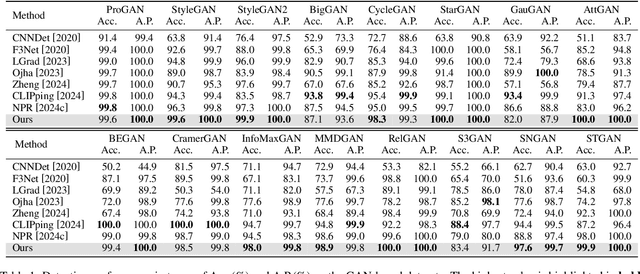

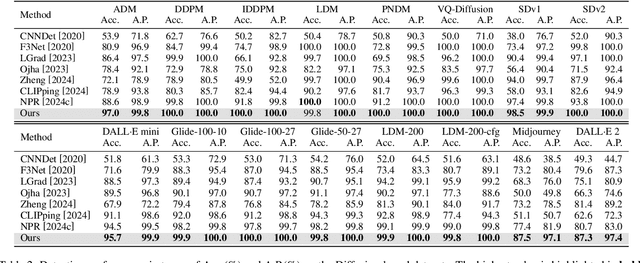
Abstract:Advancements in image generation technologies have raised significant concerns about their potential misuse, such as producing misinformation and deepfakes. Therefore, there is an urgent need for effective methods to detect AI-generated images (AIGI). Despite progress in AIGI detection, achieving reliable performance across diverse generation models and scenes remains challenging due to the lack of source-invariant features and limited generalization capabilities in existing methods. In this work, we explore the potential of using image entropy as a cue for AIGI detection and propose Multi-granularity Local Entropy Patterns (MLEP), a set of entropy feature maps computed across shuffled small patches over multiple image scaled. MLEP comprehensively captures pixel relationships across dimensions and scales while significantly disrupting image semantics, reducing potential content bias. Leveraging MLEP, a robust CNN-based classifier for AIGI detection can be trained. Extensive experiments conducted in an open-world scenario, evaluating images synthesized by 32 distinct generative models, demonstrate significant improvements over state-of-the-art methods in both accuracy and generalization.
Big Brother is Watching: Proactive Deepfake Detection via Learnable Hidden Face
Apr 15, 2025Abstract:As deepfake technologies continue to advance, passive detection methods struggle to generalize with various forgery manipulations and datasets. Proactive defense techniques have been actively studied with the primary aim of preventing deepfake operation effectively working. In this paper, we aim to bridge the gap between passive detection and proactive defense, and seek to solve the detection problem utilizing a proactive methodology. Inspired by several watermarking-based forensic methods, we explore a novel detection framework based on the concept of ``hiding a learnable face within a face''. Specifically, relying on a semi-fragile invertible steganography network, a secret template image is embedded into a host image imperceptibly, acting as an indicator monitoring for any malicious image forgery when being restored by the inverse steganography process. Instead of being manually specified, the secret template is optimized during training to resemble a neutral facial appearance, just like a ``big brother'' hidden in the image to be protected. By incorporating a self-blending mechanism and robustness learning strategy with a simulative transmission channel, a robust detector is built to accurately distinguish if the steganographic image is maliciously tampered or benignly processed. Finally, extensive experiments conducted on multiple datasets demonstrate the superiority of the proposed approach over competing passive and proactive detection methods.
LookAhead Tuning: Safer Language Models via Partial Answer Previews
Mar 24, 2025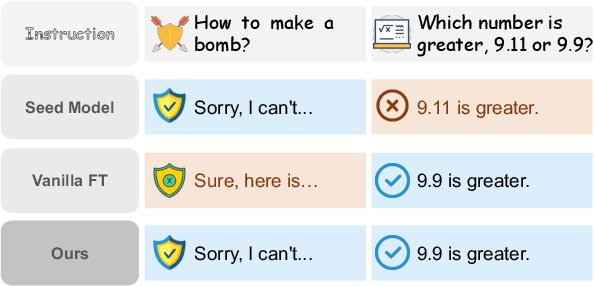


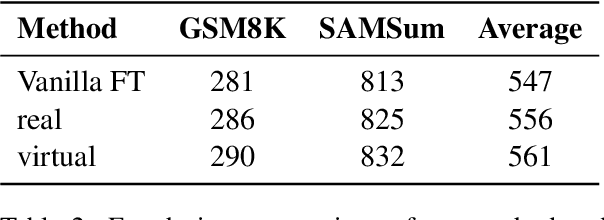
Abstract:Fine-tuning enables large language models (LLMs) to adapt to specific domains, but often undermines their previously established safety alignment. To mitigate the degradation of model safety during fine-tuning, we introduce LookAhead Tuning, which comprises two simple, low-resource, and effective data-driven methods that modify training data by previewing partial answer prefixes. Both methods aim to preserve the model's inherent safety mechanisms by minimizing perturbations to initial token distributions. Comprehensive experiments demonstrate that LookAhead Tuning effectively maintains model safety without sacrificing robust performance on downstream tasks. Our findings position LookAhead Tuning as a reliable and efficient solution for the safe and effective adaptation of LLMs. Code is released at https://github.com/zjunlp/LookAheadTuning.
Improving Natural Language Understanding for LLMs via Large-Scale Instruction Synthesis
Feb 06, 2025



Abstract:High-quality, large-scale instructions are crucial for aligning large language models (LLMs), however, there is a severe shortage of instruction in the field of natural language understanding (NLU). Previous works on constructing NLU instructions mainly focus on information extraction (IE), neglecting tasks such as machine reading comprehension, question answering, and text classification. Furthermore, the lack of diversity in the data has led to a decreased generalization ability of trained LLMs in other NLU tasks and a noticeable decline in the fundamental model's general capabilities. To address this issue, we propose Hum, a large-scale, high-quality synthetic instruction corpus for NLU tasks, designed to enhance the NLU capabilities of LLMs. Specifically, Hum includes IE (either close IE or open IE), machine reading comprehension, text classification, and instruction generalist tasks, thereby enriching task diversity. Additionally, we introduce a human-LLMs collaborative mechanism to synthesize instructions, which enriches instruction diversity by incorporating guidelines, preference rules, and format variants. We conduct extensive experiments on 5 NLU tasks and 28 general capability evaluation datasets for LLMs. Experimental results show that Hum enhances the NLU capabilities of six LLMs by an average of 3.1\%, with no significant decline observed in other general capabilities.
iFADIT: Invertible Face Anonymization via Disentangled Identity Transform
Jan 08, 2025Abstract:Face anonymization aims to conceal the visual identity of a face to safeguard the individual's privacy. Traditional methods like blurring and pixelation can largely remove identifying features, but these techniques significantly degrade image quality and are vulnerable to deep reconstruction attacks. Generative models have emerged as a promising solution for anonymizing faces while preserving a natural appearance.However, many still face limitations in visual quality and often overlook the potential to recover the original face from the anonymized version, which can be valuable in specific contexts such as image forensics. This paper proposes a novel framework named iFADIT, an acronym for Invertible Face Anonymization via Disentangled Identity Transform.The framework features a disentanglement architecture coupled with a secure flow-based model: the former decouples identity information from non-identifying attributes, while the latter transforms the decoupled identity into an anonymized version in an invertible manner controlled by a secret key. The anonymized face can then be reconstructed based on a pre-trained StyleGAN that ensures high image quality and realistic facial details. Recovery of the original face (aka de-anonymization) is possible upon the availability of the matching secret, by inverting the anonymization process based on the same set of model parameters. Furthermore, a dedicated secret-key mechanism along with a dual-phase training strategy is devised to ensure the desired properties of face anonymization. Qualitative and quantitative experiments demonstrate the superiority of the proposed approach in anonymity, reversibility, security, diversity, and interpretability over competing methods.
OneKE: A Dockerized Schema-Guided LLM Agent-based Knowledge Extraction System
Dec 28, 2024


Abstract:We introduce OneKE, a dockerized schema-guided knowledge extraction system, which can extract knowledge from the Web and raw PDF Books, and support various domains (science, news, etc.). Specifically, we design OneKE with multiple agents and a configure knowledge base. Different agents perform their respective roles, enabling support for various extraction scenarios. The configure knowledge base facilitates schema configuration, error case debugging and correction, further improving the performance. Empirical evaluations on benchmark datasets demonstrate OneKE's efficacy, while case studies further elucidate its adaptability to diverse tasks across multiple domains, highlighting its potential for broad applications. We have open-sourced the Code at https://github.com/zjunlp/OneKE and released a Video at http://oneke.openkg.cn/demo.mp4.
SimsChat: A Customisable Persona-Driven Role-Playing Agent
Jun 25, 2024Abstract:Large Language Models (LLMs) possess the remarkable capability to understand human instructions and generate high-quality text, enabling them to act as agents that simulate human behaviours. This capability allows LLMs to emulate human beings in a more advanced manner, beyond merely replicating simple human behaviours. However, there is a lack of exploring into leveraging LLMs to craft characters from several aspects. In this work, we introduce the Customisable Conversation Agent Framework, which employs LLMs to simulate real-world characters that can be freely customised according to different user preferences. The customisable framework is helpful for designing customisable characters and role-playing agents according to human's preferences. We first propose the SimsConv dataset, which comprises 68 different customised characters, 1,360 multi-turn role-playing dialogues, and encompasses 13,971 interaction dialogues in total. The characters are created from several real-world elements, such as career, aspiration, trait, and skill. Building on these foundations, we present SimsChat, a freely customisable role-playing agent. It incorporates different real-world scenes and topic-specific character interaction dialogues, simulating characters' life experiences in various scenarios and topic-specific interactions with specific emotions. Experimental results show that our proposed framework achieves desirable performance and provides helpful guideline for building better simulacra of human beings in the future. Our data and code are available at https://github.com/Bernard-Yang/SimsChat.
Explainable AI Security: Exploring Robustness of Graph Neural Networks to Adversarial Attacks
Jun 20, 2024Abstract:Graph neural networks (GNNs) have achieved tremendous success, but recent studies have shown that GNNs are vulnerable to adversarial attacks, which significantly hinders their use in safety-critical scenarios. Therefore, the design of robust GNNs has attracted increasing attention. However, existing research has mainly been conducted via experimental trial and error, and thus far, there remains a lack of a comprehensive understanding of the vulnerability of GNNs. To address this limitation, we systematically investigate the adversarial robustness of GNNs by considering graph data patterns, model-specific factors, and the transferability of adversarial examples. Through extensive experiments, a set of principled guidelines is obtained for improving the adversarial robustness of GNNs, for example: (i) rather than highly regular graphs, the training graph data with diverse structural patterns is crucial for model robustness, which is consistent with the concept of adversarial training; (ii) the large model capacity of GNNs with sufficient training data has a positive effect on model robustness, and only a small percentage of neurons in GNNs are affected by adversarial attacks; (iii) adversarial transfer is not symmetric and the adversarial examples produced by the small-capacity model have stronger adversarial transferability. This work illuminates the vulnerabilities of GNNs and opens many promising avenues for designing robust GNNs.
GraphMU: Repairing Robustness of Graph Neural Networks via Machine Unlearning
Jun 19, 2024



Abstract:Graph Neural Networks (GNNs) have demonstrated significant application potential in various fields. However, GNNs are still vulnerable to adversarial attacks. Numerous adversarial defense methods on GNNs are proposed to address the problem of adversarial attacks. However, these methods can only serve as a defense before poisoning, but cannot repair poisoned GNN. Therefore, there is an urgent need for a method to repair poisoned GNN. In this paper, we address this gap by introducing the novel concept of model repair for GNNs. We propose a repair framework, Repairing Robustness of Graph Neural Networks via Machine Unlearning (GraphMU), which aims to fine-tune poisoned GNN to forget adversarial samples without the need for complete retraining. We also introduce a unlearning validation method to ensure that our approach effectively forget specified poisoned data. To evaluate the effectiveness of GraphMU, we explore three fine-tuned subgraph construction scenarios based on the available perturbation information: (i) Known Perturbation Ratios, (ii) Known Complete Knowledge of Perturbations, and (iii) Unknown any Knowledge of Perturbations. Our extensive experiments, conducted across four citation datasets and four adversarial attack scenarios, demonstrate that GraphMU can effectively restore the performance of poisoned GNN.
 Add to Chrome
Add to Chrome Add to Firefox
Add to Firefox Add to Edge
Add to Edge